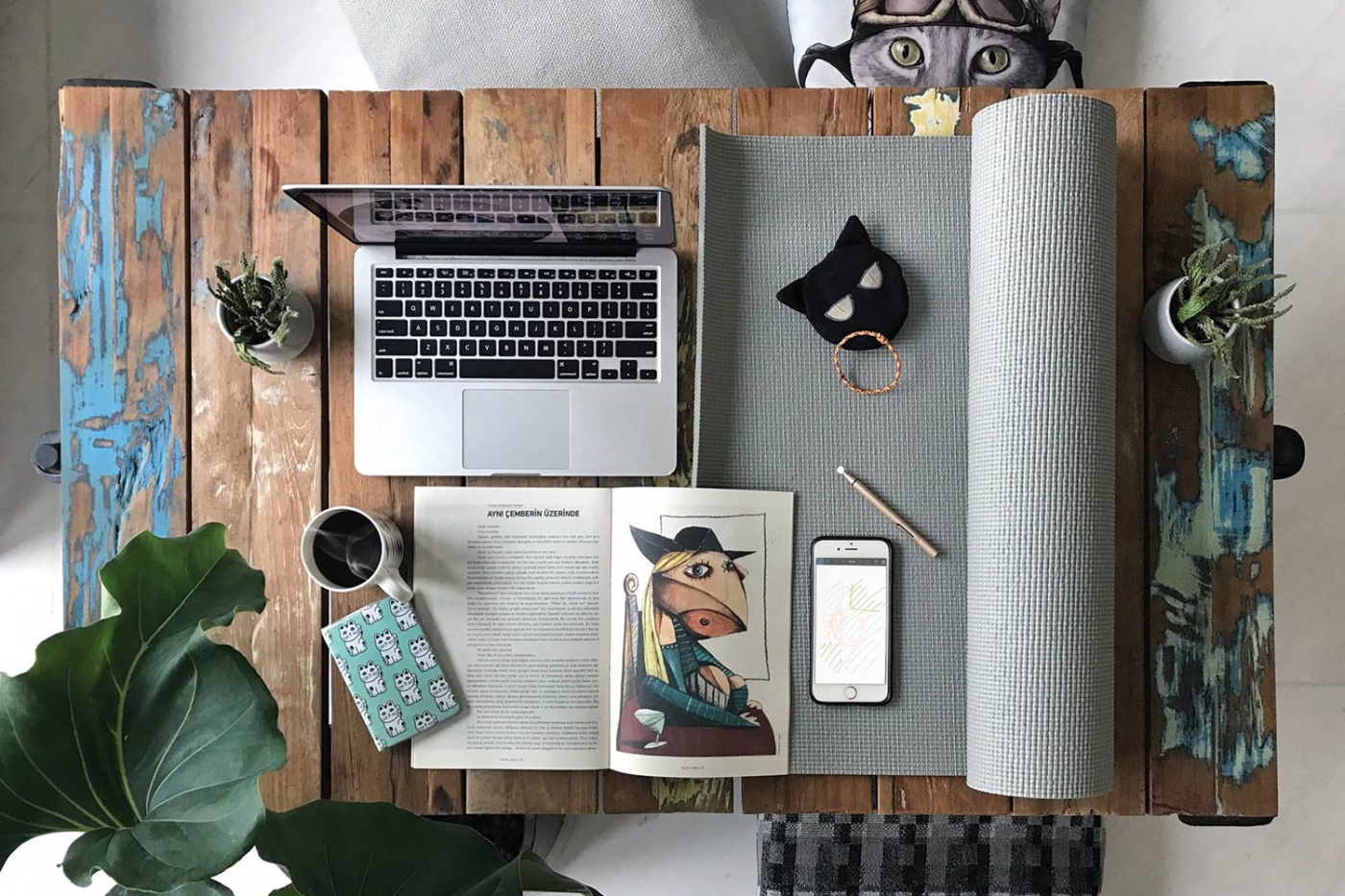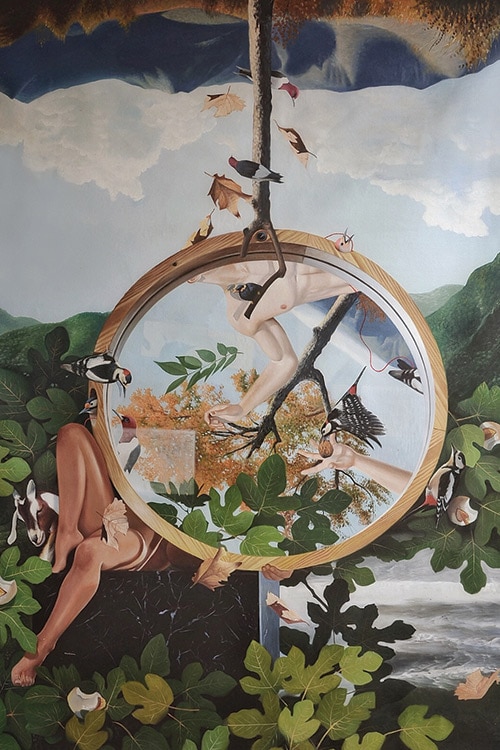Everyday Essentials with Aiman Hakim
East is east, and west is west, except in the wheel of time; it turns, and ages come and pass, leaving memories that become legend.
1.8m by 1.3m
Oil on canvas
2018
Painting is a rudimentary art form that has existed since prehistoric times. It is an integral part of human history, recording and preserving memories of an era long before we had any form of literature or photographs. Today, paintings are a vessel that carries the artist’s emotions and ideologies, expressed through their own unique vision and imagery. What differentiates a painting from a photograph is the freedom of expression, unbounded by the laws of nature, that challenges our perceptions of social norms.
Aiman Hakim’s paintings and artworks generally portray his perception of “ideals”, which are juxtaposed onto alternate realities, often slipping into the realm of fantasy. It is a visual narration of a tale, often questioning the current reality that we live in. That mindset bleeds into his portfolio—one that is constantly evolving—often crossing into other artistic disciplines such as sculptures to better represent his ideologies through different mediums.
Aiman’s daily life gives us a peek into his psyche and how he draws inspiration from his travels, people he’s met and the environment around him. Here, he shares with us his everyday essentials that fuel his endeavours as an artist.
What are the 5 everyday items that you can’t live without?
In order of importance and routine, it would have to be:
1) Coffee
2) Yoga Mat
3) Something I refer to as my good luck pouch, in the form of a black cat.
4) My ‘sketchbooks’ in the form of a MacBook Pro, iPhone (with a stylus) and a physical notebook.
5) Reading material (with pictures) from the countries I’m in at that point in time.
How do these items help to improve your lifestyle?
I do find myself travelling quite a bit for work, so essentially, the items help stitch together a routine that grounds and centres my day-to-day, regardless of the time zone or foreign surroundings I find myself in at any given point of time.
Do these items reflect your personality too?
For ease of organisation and to maintain a sense of visual calmness, I tend to only buy items that are grey, black, or of earth tones. I try to live a minimalist lifestyle, but sometimes I do make an odd purchase of whatever is in line with the theme of a crazy cat lady. I’ve been told by friends that it’s very easy to buy me gifts based on either hues or themes.
Is there a story behind any of them?
Each of the items works hand in hand in my day-to-day; they keep me in tune to my mental and physical needs, as well as my passions and commitments.
My spirituality and morning routine of yoga and meditation grounds me as a person and in my practice, so it is essential for me to always have a yoga mat (the one featured here is used specifically for travels) and my ‘black pouch’ of charms.
I like browsing through bookstores and magazine racks for local (or foreign) publications. As I’m currently in Turkey now for an assignment, Kafkaokur; a literature, design and art magazine caught my eye, and I used a Scan & Translate app to read it. In addition, it helps me expand my Turkish vocabulary beyond the basic niceties of “Hello!” and “Is this chicken?”
Why did you decide to become an artist—and why art in the form of a painting?
I’ve always been curious about observing, and having a greater understanding of human emotions. Growing up, I was always the quiet one. I would observe interactions between my peers, and relate them to my writing and drawings. I’m still very much that person, but instead of just observing, I enjoy having conversations, processing the information, and attempting to connect those dots through my art practice. Being an artist was an intuitive progression that I decided to listen to, and run with.
I like a painting’s ability to reach out to all the different kinds of experiences, chaos and multiple realities—thereafter compressing it and bringing it to a visual equilibrium, while still maintaining the integrity and depth of all its layers.
What are the struggles of pursuing a career as an artist?
Struggles are aplenty, but it’s all relative. If I’m being completely honest, one of them is having to write down the answers to this question all the time throughout my career. I think this question requires a book deal and an advance payment.
What is your typical day like?
Unless I’m having a terrible jet lag, I like to ground myself with a morning routine of coffee, yoga, and meditation. Sometimes I get overlays of shapes and visuals during meditation that don’t make immediate sense, so I try to jot those down first, but for me, it’s important to keep the first hour of my day away from distractions such as my phone and emails. After that, I continue where I left off the day before, and immerse myself in work till the evening. This flurry of activity can be anything from painting, research, sketching, to writing proposals. Usually, I try to do an online class after dinner for about 40 mins a day, and then end my day with another meditation.
How do you gain inspiration for your paintings?
I think of art as a reflection of life and instinctually, I see my personal experiences as a journey; the opportunities that present themselves, the people that I meet, and the conversations that I’ve had as a guide to creating art. Sometimes you just have to trust the process and go with it.
How do you record your ideas?
I write ideas down on my notebook when it gets a little too complicated to hold all of them in my head. Next, I visualise them using basic shapes, composition and colours, and sketch them out using an app on my iPhone. Details of the composition are then further explored in my notebook. As an artist, I recognise that time is one of your greatest expenses, and though nothing is certain, this working process helps prevent me from making expensive mistakes. I guess my whole creative approach is very systematic; I draw everything out ahead of time. This allows me to have a solid foundation and removes guesswork during the execution process.
What is in your toolbox?
Approximately a year’s rent worth of paints/brushes and solvents.
What is the most important tool you must have to create art?
Experiences that I draw inspiration from, and a morning meditation that helps me decode and put them into a visual perspective.
What is your favourite tool when it comes to painting?
My palette knife; I like mixing colours. It’s very therapeutic. I especially like slicing a dollop of paint into two before you drag it across the palate. There’s just something really calming about that feeling.
How did your work start to involve sculptures?
It started when I was creating a series called “Toy Story 2”. I started assembling found objects and toys onto an acrylic table top, to map out the visuals in my artwork. I loved the sensitivity of how the slightest tilt in viewing a prearranged model can drastically affect the perceived image. I also especially liked the idea that every single item was created for a specific role through the idea of play, and I wanted to disrupt that very intention to give them new identities.
At one point, I got annoyed at how limiting my work was and decided to flip the creation process. So I started to pick up the necessary skills to make that happen, and I ended up creating sculptures from the initial sketches that were originally meant to be paintings.
Do you see yourself exploring different mediums and branching out into other disciplines?
I am always experimenting and looking for ways to expand my creative output, so that is very much a possibility.
Do you have creative freedom over client projects?
Most clients who hire me are familiar with my style and trust my aesthetic, so I haven’t had an issue with regard to creative freedom. I do, however, like to get a sense of who my clients are and/or the intention of the commission before I create the artwork. There is always a lot to consider when you’re commissioned, but for me, two of the main things to consider are the visual and cerebral impact.
How would you define your style as an artist?
Essentially, I’m a figurative painter, but I do pay attention to the formal qualities of a painting; its non-naturalistic images of shape and composition, as much as its representational qualities. I also look at form, the balance of space and how they all relate, to avoid any sort of unnecessary visual tension.
Your work is generally based around a certain ideology. Do you leave that interpretation open to the audience or do you aim to convey the message clearly?
I like to approach my work as a dialogue like a conversation with an old friend over coffee; you start off with the obvious greeting before slowly easing into the conversation, then building up trust where you are completely honest and vulnerable, without any barriers or walls. Personally, those kinds of conversations are the ones that linger long after they are over. The connection with the audience is just as important as the work itself, which is why I like to work with the nuances of everyday life. It makes the painting more three-dimensional in its reception.
Any advice for those who want to pursue a career in art?
Don’t buy into the idea of ‘struggling’ as a source of inspiration. Be inspired by experiences instead; the struggle is only a part of the experience. At the end of the day, what we choose to put our attention on, grows, and ultimately we want to water the flowers, not the weeds.



